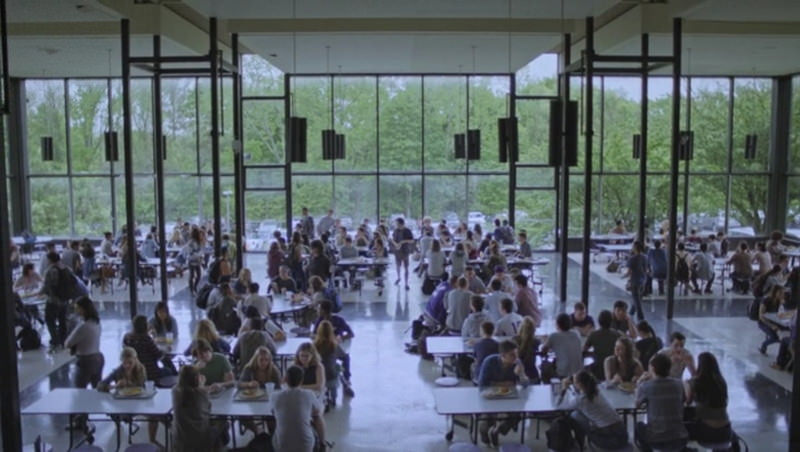Filmed at the Pleasantville Campus, Netflix Hit Show ‘The OA’ is as Strange as it Gets
The season finale of the Netflix Original series, The OA, defines itself as something of a paradoxical phenomenon, fraught with dance routines, drama, and violence all within one confused, sci-fi package. What is even crazier is how part of this finale was shot in the cafeteria of Pace’s once-owned Briarcliff Manor.
The grand finale of this highly confusing tale took place in the very spot where Pace alumni once enjoyed their lunches. It was incredibly surreal to see the camera placed in the perspectives of the students who ate and bantered, all while being within the glow of the sun as it permeated through the trees outside and the large cafeteria windows.
What was even more surreal was seeing a gunman open fire around the cafeteria and make his way inside. This is just one example of how the episode “Invisible Self” contains an overload of themes, dramatic situations, and bouts of confusion that made the watching experience a tad irritating.
The OA really tried to envelop the audience in its mixed storytelling and odd amalgamation of events that seemed to string together, but really didn’t. In the initial few minutes of the episode, main protagonist OA, or Prairie Johnson as she is also known as, is instructed to heal an officer’s wife who has ALS with her friend called Homer. The two gifted young adults do so, but come in tender close proximity that doesn’t sit well with their mad scientist kidnapper, Hap. As a result, OA is discarded into the woods, forgotten and left for dead. Flash-forward and it is revealed that Prairie was recounting her story to her new friends in her village neighborhood.
After, the episode takes a direction from mad science and sociopathic kidnapping to family troubles and child legitimacy with introducing Abel and Nancy Johnson, OA’s caretakers. In the midst of that, OA’s friends are trying to find evidence to prove her story true. This disconnection between themes and motives really derails the engagement into the overall tale and leaves more confusion than interest or discovery. It seemed as if this final episode really wanted to attack every aspect of the show instead of just developing one and letting the audience have its day. However, one thing the episode was tenacious towards was its tone.
Tonally, “Invisible Self” is very dark and depressive, as evident through the cinematography. Shadows line the characters’ features as if to cast a permanent veil of mystery and deception over them. Colors are washed out, practically painting Prairie Johnson’s world with her melancholy thoughts and introspection. Even the camera captured the emotions in the episode with close-ups on tear-jerked faces and dynamic shots of OA in various scenes. In addition to cinematography, acting is also where the episode shined. In particular, Brit Marling as OA performed brilliantly as an emotionally disturbed adolescent with quite the ghost story. The audience could see the magnitude of her contemplation and turmoil through her facial expressions and sometimes unpredictable actions. This unpredictability certainly leaves you questioning the ending in the cafeteria, as well.
The choreographed dancing during the gunman portion of the episode was something so absurd and laughable that you would just have to see it for yourself. It is bad enough that the finale decided to delve into the topic of school shootings, in conjunction with everything else.
Maybe at some point, I will watch the other seven episodes of the season and understand the odd choices and overall air of sci-fi mystery from OA’s strange powers to her even stranger past. I recommend looking into this series if it so pleases you, but just be cautious: it’s going to get weird.
Your donation supports independent, student-run journalism at Pace University. Support the Pace Chronicle to help cover publishing costs.

